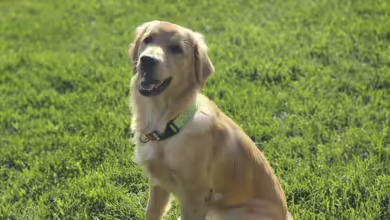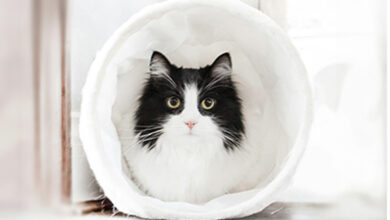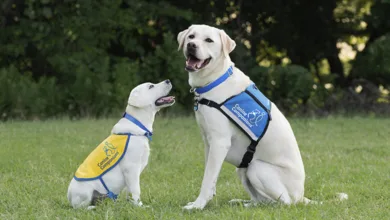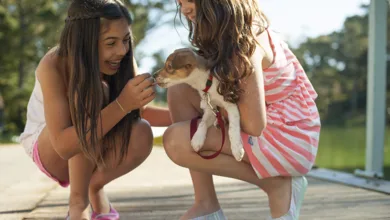What’s My Dog Trying to Tell Me?
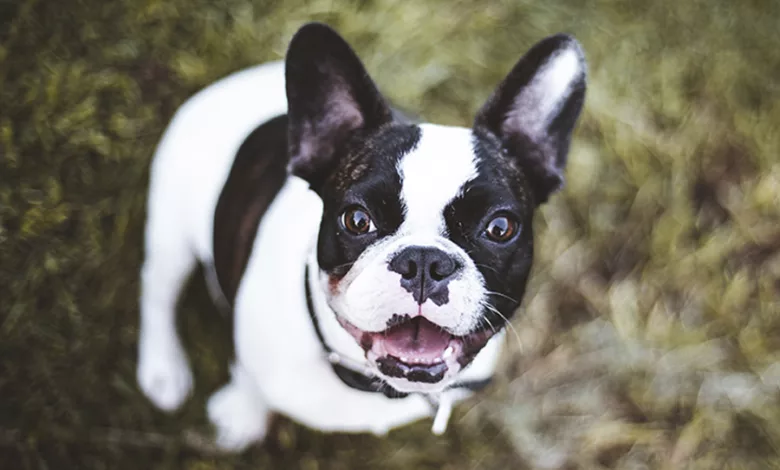
“Oh, I know that look!”
This is what I’ve often said to my friends when they point out my dogs’ bright-eyed stares, ears erect and tails wagging. My boys are ready for their dinner NOW!
Some facial expressions and body language are easy or obvious to interpret. But so many of us are not aware of the true lexicon of canine facial expressions and body language. If we did, it would make a loving canine-human relationship truly ideal.
So, with the help of Pat Miller, training editor of The Whole Dog Journal and one of my heroes in the dog-training world, let’s break it down.
It’s not just the face that gives humans and other animals an indication of mood and needs. One must consider the dog’s whole body, too.
But the face is the first place we usually look to for interpretation. The eyes, ears, and mouth give great clues. Here’s an easy one we’ve all experienced.
The pup’s gaze has eyes soft, rounded, or almond shaped, with pupils either appropriately large or small depending on the environmental lighting. He is indicating a relaxed and often devoted feeling of pleasure or love. Add to that a wagging tail and a curved or wiggly body, and you’re in the presence of a happy dog.
On the other hand, if you encounter a dog who is giving you a hard, piercing stare — one that feels unfriendly — and his body is stiff with erect ears and a stiff or slowly wagging tail, this dog may be about to bite. Do NOT stare back. Doing so is a sign of aggression.
Dogs naturally look away as a sign of deferment to both humans and other dogs. Don’t try to make your dog hold your gaze when you are loving on him!
Squinty eyes can mean one of two things. If her eyes are squinting and she’s approaching you, this means she is in appeasement mode. But if she is hanging back or retreating while squinting, this is a signal of fear. Don’t approach; at least give the dog some space.
What about ears? They are either pricked forward, pricked back, or relaxed. If your dog has ears that stand up as typical for her breed, ears pricked hard forward means she’s attentive, aroused, or happy in the moment. BUT it can also mean she feels threatened and fearful, requiring an aggressive stance.
What’s the rest of her body doing? Is she relaxed, or has she gone stiff? Even droopy-eared dogs can raise the base of their ears to come across as erect.
No matter the ear type, pinned-back ears can mean Fido is in appeasement mode, which can be either a sign of deference or one of fear and stress. Look at the rest of his body to determine which ear signal makes the most sense in that moment.
And regardless, “relaxed ears generally mean a relaxed dog,” according to Pat Miller.
Dogs’ mouths also give distinct clues to their mood. When the pup is relaxed, her mouth is either closed or slightly open. But it is wrinkle-free and “soft,” with no tension lines around it. If her mouth is open, then slowly closes with added tension lines, and her body goes very still or stiff, something is wrong in her world. This posture could be the precursor to a bite.
Dogs pant for two reasons. They’re either hot (dogs can’t sweat and release excess heat by panting) or stressed. Stress and distress panting is often very fast and shallow; relaxed panting is often slower and deeper.
Yawning is something we all see a lot. It can mean the pup is tired or maybe just saw YOU yawn. It may mean also he feels stressed (another dog is in his space, or an unfamiliar human has come into the home), so watch for clues from the rest of his body.
LICKING! It can be annoying, but there are several reasons it’s happening. Sometimes dogs lick to greet or appease. Sometimes they lick themselves persistently due to allergies or because of a canine compulsive disorder. And — again — sometimes dogs lick their lips because they’re stressed. Once more, what is the rest of the dog’s body and behavior telling you?
Finally, there’s “commissure.” Miller described it best: “This is just a fancy word for the corners of your dog’s mouth.” Note how the commissure looks when your dog is calm and relaxed. Miller suggested you remember it for comparison purposes.
There are two significant variations on the commissure. If the corners are pulled forward and the commissure forms a “C” shape, the dog is being offensively aggressive. If the corners are pulled tightly back, forming a “V” shape, the dog is being defensively aggressive.
Either way, watch out!
So, now that we know more about what Fido is feeling in any given situation, we can either take appropriate action or just heap on the love. At least now there is less confusion about when to do either!
Our dogs communicate with us non-stop, and it’s up to us to make both their lives and ours easier — and better — by listening.


